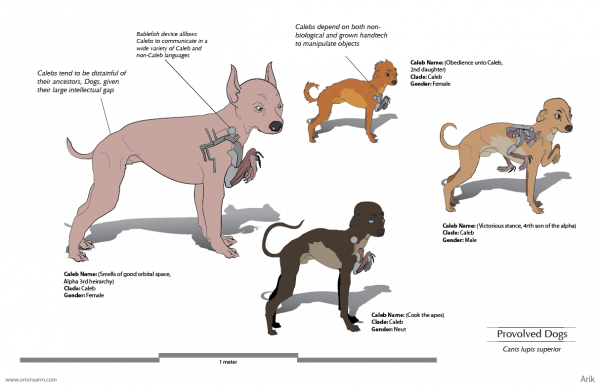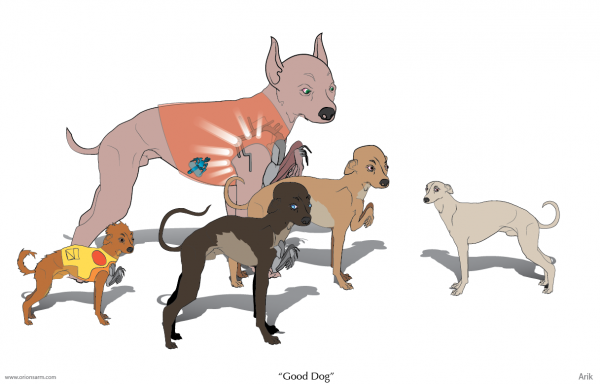BY LETTER
Calebs (Talking Dogs)
It was perhaps inevitable that the first species domesticated by humans would also be the subject of some of the earliest attempts to increase intelligence in a nonhuman species. In the case of the original Neo-Dog project, initial efforts fell short of actual provolution both by design and effect, but full provolution did eventually follow.
Efforts to increase canine intelligence using primitive genetic manipulation techniques, along with postnatal biomods, cyberware, and nootropic drugs, were well underway with many animal species long before the first true "provolution" attempts were made. In the case of dogs, the aim was to make them better workers at jobs they had done for humans since antiquity. This meant giving the dog the ability to communicate more effectively with human controllers, to understand more complex orders and instructions, to and carry out more complicated operations with less training, rather than gifting dogs with full sapience and independence.
As with any experimental program, there were many failures, and these drew no small amount of criticism from animal rights activists and dog lovers. The first truly successful "Neo-Dogs", or "Calebs" as they were technically known, had mental abilities roughly equal to those of an adult human baseline with a moderate intellectual disability. However, such a comparison may be misleading, since a well-crafted, fully-trained Caleb was in not a disabled human but an enhanced dog: a stable, complete, and a highly-competent expert in his or her field.
The first "production model" Calebs were announced in 220 AT (2189 c.e. on the Old Earth calendar). Physically, these first Neo-Dogs appeared little different from the Shepherd, Doberman, and Labrador breeds from which they were derived (Neo-Dogs were then, and for a long time continued to be, large breeds exclusively). The main visible differences between the Calebs and ordinary canines were a larger, more rounded cranium and visible DNI ports (the latter were more discrete as technology advanced). Neo-Dogs also had smaller, flatter muzzles with more-mobile lips, and smaller, less-mobile ears. Every effort was made to preserve the dogs' formidable sensory abilities, particularly their sense of smell. However, designers inevitably had to make some compromises between cognition and sensory ability, given the limited bio and cybertech of the days and the limitations of the baseline-to-superbright human design teams.
Though their hearing and sense of smell were vastly superior to those of baseline humans, and even still on par with most non-provolved Terragen mammals, Neo-Dogs' sensory capabilities still initially fell short of those in their unaltered canine cousins. Nearly everyone who worked with Neo-Dogs or saw them in action, however, maintained that the Neo-Dogs' improved reasoning and cognitive abilities, judgment, trainability, and communicative abilities, more than made up for this.
All Calebs intended for use in police, military, or rescue work were equipped with specialized DNI which allowed the dog to relay its sensory impressions and thoughts unobtrusively and virtually instantly to their handlers, and to receive instructions in return. A specially-designated and conditioned handler was assigned to each Caleb, and was the only one the Neo-Dog could communicate with or receive orders from in this way. Training the canines to handle having the thoughts of a human in their own minds was the trickiest part, though many, including trainers and handlers of Neo-Dogs, claimed it was the dog who had it relatively easy. The bonding process of joining a particular Caleb to a particular human "host" (often euphemistically termed that Neo-Dog's "alpha"), who would be the Neo-Dog's handler thereafter, has been described not too inaccurately as deeper and more intimate in a mental sense than most Human marriages. If one member of a Human-Caleb pair was killed the surviving member, human or canine, suffered severe psychological trauma, especially if the DNI link was active at the time. Sometimes to the survivor was even forced into catatonia. In the case of Humans, the subject could be slowly, painfully rehabilitated and put back together by the appropriate psych techs. In the case of the Neo-Dog, however, the subject was generally terminated, painlessly and immediately if possible. This was another factor which placed the designers and users of Neo-Dogs on permanent bad terms with animal rights activists and most dog lovers.
In addition to their DNI links, Neo-Dogs were given a modified larynx and palate and improved breath control so that they could produce human-like speech. The more difficult work of upgrading language and associative centers of the dogs' brains had already been done to increase trainability and DNI compatibility. Opinion is mixed as to just how effective the speech mods were. Neo-Dogs were able to produce human-like speech, but it had a ubiquitous "growling" quality and was deep-pitched even in smaller females. Neo-Dogs were also unable to shape their mouths properly to form the consonants B, M, P, and V. Humans needed to "train" themselves to become attuned to the Neo-Dogs' peculiar accent.
Neo-Dogs were still able to speak "dog," utilizing the regular canine modes of communication. However, they seldom did so except with each other and even then only rarely. Neo-Dogs showed a marked lack of interest in interacting, verbally or otherwise, with their baseline relatives, or for that matter with anyone other than their colleagues and handlers. Ordinary canines returned this sentiment, reacting to Neo-Dogs, when encountering them, with a mixture of trepidation, veiled hostility, even disdain, as if saying to the Neo-Dogs, "Who, or what, are you? You're not one of my kind, that's for sure!" Considering that even the brightest unmodified canine was effectively a lower-functioning moron (though with senses somewhat sharper, and more in touch with its inner wolf), compared with even the most deficient acceptable Neo-Dog (Neo-Dogs who did not score within acceptable intelligence parameters, or were defective in any significant way that could impair their job performance ability, were painlessly culled), this shouldn't be surprising. Nevertheless, this reduction in fabled canine "chumminess" was one of the most lamented features of Neo-Dog. Along with their cost, and restrictions on ownership, this kept them from ever attaining much popularity. Most human children who claimed they wanted a Neo-Dog for a pet changed their minds after encountering one for the first time. While of course strongly conditioned against hurting any human unless ordered or if that human actually presents a physical threat, and even then trained to subdue with minimal force or injury, Neo-Dogs simply didn't respond to unfamiliar humans, children or otherwise, the way unmodified canines did. "Robodogs" and "canine equivalent of Mr. Spock" were common nicknames representing baseline human impressions of the seemingly over-reserved and passionless Neo-Dogs. The simple fact was, Neo-Dogs didn't mesh well with ordinary dogs or with (most) humans, because they were neither dogs nor humans. Rather, despite still being canines with many superficial similarities, Neo-Dogs were a separate variety of being in their own right.
Rounding-out the standard Neo-Dog package was a nearly doubled lifespan: after reaching maturity and completing training, a Neo-Dog typically had a useful service life of 20 to 25 Earth years, after which they usually retired peacefully and were more often than not adopted by their former trainers or handlers. There were also reduced hormone levels and libido, resulting in a (most welcome for many humans) much-reduced tendency to sniff human groins and posteriors or to attempt mating with human extremities.
Neo-Dogs figured prominently in innumerable police, rescue, and military operations in the late 1st through the early 3rd centuries AT, proving their worth time and again as genuine improvements over ordinary canines in the latter's traditional lines of work.
Circa 300 AT Neo-Dogs were provolved further to full sophonce, and were given their independence and full civil rights in several jurisdictions (although not in all). Because they lacked hands and opposable thumbs, Neo-Dogs often used servitor robots to manipulate objects at their command. Some Dogs began to use primitive 'handtech' to perform these tasks.
Many fully sapient provolved Dogs (often termed Talking Dogs) continued to work long after in their ancestors' traditional lines of work. They simply couldn't think of anything else they were better-suited for or that appealed to them more. Many ended up heading the departments their ancestors once worked for, resulting in the strange irony of provolved dogs "barking" orders at human (and of course other) subordinates.
When the population of Earth was expelled after the Technocalypse, a very few Talking Dogs remained on Earth; most were expelled, loyal still to their human masters, and many were sheltered in Caneshe Habitat in one of the Earth/Sun Trojan points, and from there spread out across the galaxy, in particular to the many-mooned world of Rufus.
Related Articles
Appears in Topics
Development Notes
Text by Mike Parisi
Initially published on 11 December 2004.
Initially published on 11 December 2004.










